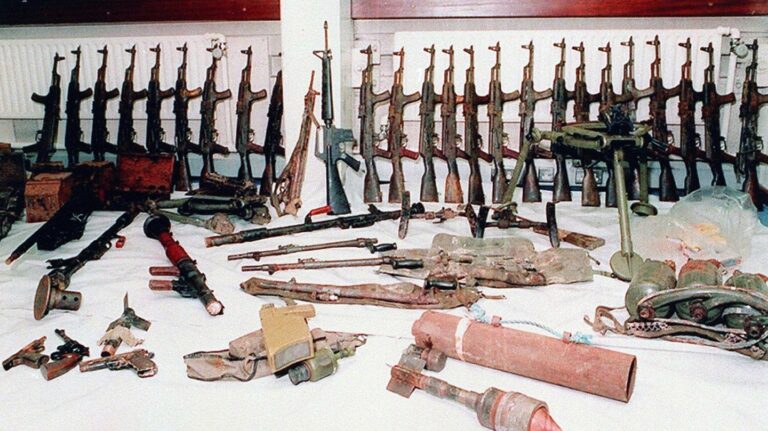Disarming Violence: Decommissioning and the Northern Irish Peace Process
Weapons of the Paramilitaries

The number and variety of weapons used by paramilitaries during the Troubles posed a challenge to the goal of decommissioning. Groups like the Provisional IRA used an eclectic of small arms and explosives from across the globe to wage their campaigns. One of the IRA’s main sources of guns and money was the United States. With a large Irish diaspora and relatively easy access to weapons, the U.S. was key to their armed campaign. Irish-American George Harrison served as a key gunrunner for the IRA starting in the 1970s. His network moved a large number of weapons, and in 1971 security forces confiscated over 700 guns and over 170,000 rounds of ammunition.[1] As the FBI cracked down on gun smuggling from the U.S. in the 1980s, the IRA found a new source of weapons in Libya with the help of Colonel Muammar Gaddafi. After the British government put diplomatic pressure on the Libyans, the IRA again found itself without a supply line of new guns. Their inability to resupply their arsenal also contributed to the IRA’s resistance to decommissioning, as they realized anything they gave up could not easily be replaced.[2]
Exact figures for the number of weapons illegally held in paramilitary hands during the Troubles is unsurprisingly hard to come by, though most estimates show that militants were well armed. The Provisional IRA’s stockpile was suspected to include over numerous sporting rifles and shotguns, 600 AK-47 assault rifles (mainly from Libya), dozens of light machine guns and heavy .50 caliber machine guns, and numerous rocket-propelled grenade (RPG) launchers.[3] The IRA also made heavy use of the lightweight and compact ArmaLite AR-18 and Colt AR-15 rifles (often simply called “ArmaLites”) acquired in the U.S., which can be commonly seen in propaganda and frequently referenced in republican music.[4] The IRA further utilized Semtex, a commercial mining explosive, in the production of homemade bombs. In one notable example, the IRA built their own mortar launcher to attack 10 Downing Street in 1991. With up to 3 tons of explosives at their disposal, homemade weapons like mortar launchers and rocket launchers posed a further obstacle for decommissioning due to the difficulty in estimating their numbers and distribution.[5]
Loyalist forces also owned large stockpiles of weapons. The Ulster Defense Association was believed to possess over two hundred handguns, numerous Uzi submachineguns, and at least two hundred AK-47s before decommissioning. The Ulster Volunteer Force possessed a similar arsenal, with some additional RPGs as well. Much like republican paramilitaries, loyalists used commercial explosives to produce homemade bombs. Both republican and loyalist forces developed some homemade firearms, but this seems to have been more common for loyalists, possibly due to them having less of a base of support in the U.S.[6] With many thousands of firearms and tons of explosives in paramilitary hands, any effort to disarm militants would be a daunting task.
[1] English, Armed Struggle, 115-117.
[2] Sean Boyne, “Inside the IRA – Weapons and Technology,” PBS Frontline, Jane’s Intelligence Review, 1 August 1996. Accessed 23 April 2022. https://www.pbs.org/wgbh/pages/frontline/shows/ira/inside/weapons.html.
[3] Martin Melaugh, “Estimates of the Strength of Paramilitary Groups,” CAIN Archive, CAIN Web Service, Accessed 22 April 2022. https://cain.ulster.ac.uk/issues/violence/paramilitary2.htm.
[4] “IRA Poster 1974,” Examples of IRA Posters, CAIN Archive. CAIN Web Service. Accessed 3 March 2022. https://cain.ulster.ac.uk/images/posters/ira/index.html.
[5] Sean Boyne, “Inside the IRA – Weapons and Technology,” PBS Frontline, Jane’s Intelligence Review, 1 August 1996. Accessed 23 April 2022. https://www.pbs.org/wgbh/pages/frontline/shows/ira/inside/weapons.html.
[6] Boyne, “Inside the IRA – Weapons and Technology,” https://www.pbs.org/wgbh/pages/frontline/shows/ira/inside/weapons.html.